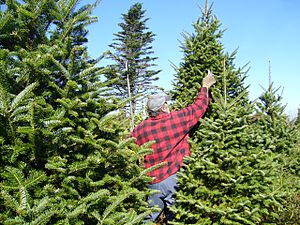Christmas tree production in Canada facts for kids
Canada grows a lot of Christmas trees every year, usually between 3 and 6 million! These trees are grown in many parts of Canada. The provinces that grow the most Christmas trees are Quebec, Nova Scotia, and Ontario. Together, they produce about 80% of all Canadian Christmas trees. In British Columbia, about 900,000 trees are cut each year, and most of these come from natural pine forests.
Contents
How Christmas Tree Farming Started in Canada
Growing natural Christmas trees in Canada began much like it did in the United States. Before the 1930s, almost all Canadian Christmas trees were simply cut from wild forests nearby. As more and more people wanted Christmas trees, growing them on special farms became popular.
Today, about 40 million Christmas trees are cut in North America each year. Of these, 3 to 6 million come from Canadian Christmas tree farms and natural forests. The top three provinces for Christmas tree production are Quebec, Nova Scotia, and Ontario. They grow about 80% of all Canadian Christmas trees.
About half of Canada's Christmas tree harvest is sent to other countries every year. Most go to the United States, but some also go to the Caribbean and Central America. Between 1995 and 1997, Canada's Christmas tree exports to Germany grew a lot, by 380%!
In 1995, there were about 126 square kilometers (126,000 acres) of land used for growing Christmas trees in Canada. This land was spread across 4,077 farms. Quebec, Nova Scotia, and Ontario each used about 22-24% of the total land for Christmas trees. In 1995, 3.2 million trees were cut, and Quebec provided 32.5% of them.
By 2004, Canada cut 3.9 million Christmas trees. This crop was worth about $62 million. About 2.5 million of these trees were exported, bringing in $36.2 million. By 2015, the number of farms had dropped to just under 2,400, but the industry was worth over $78 million.
Christmas Tree Production by Province
British Columbia's Trees
Every year, about 900,000 Christmas trees are grown in British Columbia (BC). Most of these trees are cut from natural forests, especially in the East Kootenay area of BC. While 75% of the trees come from wild areas, about 450 individual farmers grow trees on plantations. These Christmas tree farms in British Columbia are found in the Fraser Valley, on Vancouver Island, and in the Okanagan, Thompson, and Kootenays regions.
Nova Scotia's Famous Trees
The Christmas tree business in Nova Scotia is worth $30 million each year. About 3,500 people are involved in growing and selling these trees. Over 1.8 million trees are harvested annually, and 95% of them are sold outside the province. This industry provides 500 full-time jobs and seasonal work for 2,500 people in Nova Scotia.
Between 1996 and 2001, the land used for Christmas tree farming in Nova Scotia decreased by 18.1% to 23,450 acres. There were 535 farms, which was one-third fewer than in 1996. Even with less land, Nova Scotia still led Canada in the amount of land used for growing Christmas trees.
Perhaps the most famous Christmas tree from Nova Scotia is the Boston Christmas Tree. This tree is given by the province to the people of Boston every year. It's a way to remember how Boston helped after the terrible Halifax Explosion. Usually, the Boston Tree comes from a natural forest where trees grow freely, but sometimes it's donated by a Christmas tree farmer.
Ontario's Christmas Tree Farms
According to numbers from 2001, Christmas tree farms in Ontario covered about 30,000 acres. The trees grown there were worth a total of $8.3 million.
Prince Edward Island's Smaller Industry
Prince Edward Island has a smaller Christmas tree industry. Some farmers offer "u-cut" options, where people can come and cut down their own tree. They also sell trees to local stores. The main type of tree grown is the Balsam Fir, with some pines and spruce trees too. Many farmers plant young trees in old fields. There's also growing interest in managing Balsam Fir trees that grow naturally in areas where other trees have been cut down.
In 2009, about 80,000 Christmas trees were sent from Prince Edward Island to the United States.
Quebec's Balsam Firs
Quebec, along with New England and other provinces in Atlantic Canada, is a major grower of Balsam Fir trees for Christmas. The Balsam Fir is one of the most popular types of Christmas trees in North America. In 1997, Quebec produced almost 1.9 million Christmas trees. About 80% of these were sent to the United States and Mexico to be sold. The other 20% were sold locally in Quebec.
Other Canadian Christmas Tree Areas
Besides the main Christmas tree growing provinces, trees are also grown in smaller numbers in other parts of Canada. In 1998, the government of Newfoundland and Labrador started a plan to encourage people to become Christmas tree growers. In 2000, the province imported about 17,000 Christmas trees each year, worth $400,000. Between 1998 and 2000, the government held training workshops to help more local people become Christmas tree farmers.
The Christmas tree industry in Saskatchewan is small and was just starting to grow in the early 2000s. Saskatchewan produces about 12,000 Christmas trees each year.
See also


